Pacific Islanders lagging
on income, says Census
A report also shows that
their median age is seven years
less than the U.S. average
Native Hawaiians and Pacific Islanders in the United States are more likely working than the general population, but they also are making less money, according to a new Census Bureau report released yesterday.
The report, based on the long-form Census 2000, shows 860,965 people said they had some native Hawaiian or Pacific Islander heritage. Of that number, 378,782 reported solely native Hawaiian or Pacific Islander status.
The census shows 400,435 reported having some native Hawaiian blood. Of those, 139,495 reported being only native Hawaiian.

Native Hawaiians make up the largest group in the category -- about 36.8 percent -- followed by Samoans, 22.5 percent; Guamanians, 14.6 percent; Tongans, 7.3 percent; Fijians, 2.7 percent; Marshallese, 1.5 percent; and other Pacific Islanders, such as Tahitians, Chuukese and Mariana Islanders, 14.6 percent.
Pacific Islanders age 16 or older were more likely to be working (71 percent) than the general population (58 percent). Pacific Islander women also made up a higher percentage of women (61 percent) in the workplace than all women (58 percent).
Of the six major occupational categories, Pacific Islanders are most likely to hold sales and office jobs (29 percent), followed by management and professional jobs (23 percent). However, the percentage of Pacific Islanders in management was lower than the general population, and Pacific Islanders were more likely to be in the service industry.
The median family income for Pacific Islander families was $45,915, compared with $50,046 for the general population. Native Hawaiian ($49,680), Guamanian ($49,122), Fijian ($46,333) and Tongan ($46,333) families had the highest median incomes.
About 1 out of 6 Pacific Islanders lived in poverty in 1999. Marshallese (38 percent), other Pacific Islanders (21 percent), Samoans (20 percent) and Tongans (20 percent) had the highest poverty rates.
Pacific Islanders also tend to be younger, with a median age of 28 compared with 35 for the U.S. population, which could account for the higher numbers in the work force. Women outnumber men above age 64, while men outnumber women below age 35.
In 2000, 78 percent of all Pacific Islanders 25 years and older had completed high school, on par with the general population. But only 14 percent had a bachelor's degree or more education compared with 24 percent of the general population. Native Hawaiians, Guamanians, other Pacific Islanders and Samoans had the highest percentages of college graduates.
The report shows a higher percentage of families in Pacific Islander households (79 percent) than the general U.S. population (69 percent). About half of those over 15 are married, with Tongans (62 percent) and Fijians (58 percent) having higher percentage of married people than the U.S. population.
The report is available online at www.census.gov/prod/2005pubs/censr-26.pdf.
E-mail to City Desk
[News] [Business] [Features] [Sports] [Editorial] [Do It Electric!]
[Classified Ads] [Search] [Subscribe] [Info] [Letter to Editor]
[Feedback]
